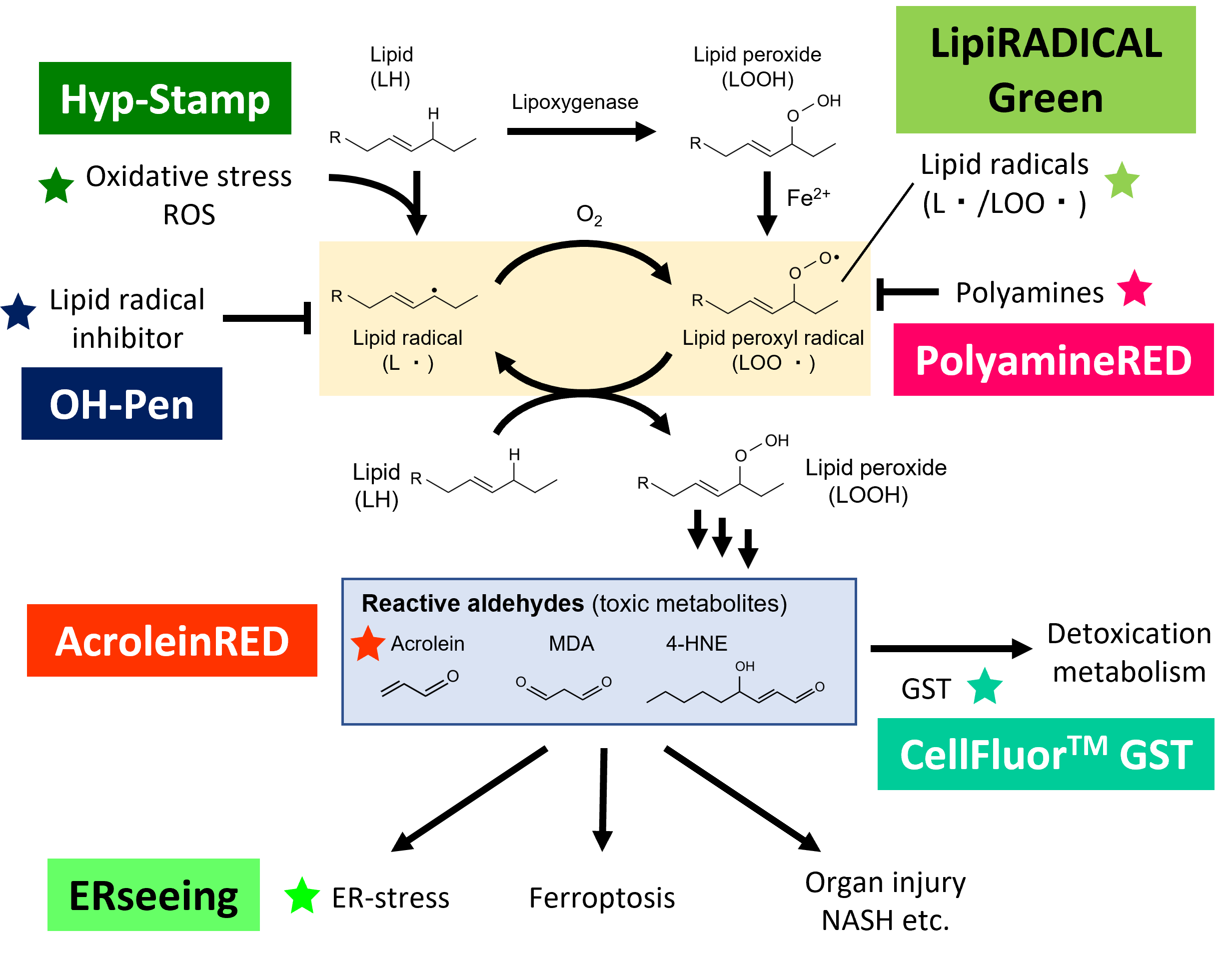Oxidative Stress in Cancer Research Lipid Peroxidation Detection Tools for Cancer Research
Date:March 27 2023Web Page No:520059

Funakoshi Co.,Ltd.
Oxidative stress is widely recognized as an important factor in cancer development. Cancer cells show higher reactive oxygen species (ROS) levels as well as upregulated antioxidant activity. Oxidative stress promotes lipid peroxidation (LPO) which is one of the several degradation processes of lipids. Quantitative measurement of LPO is utilized for the evaluation of anti-cancer drug of antioxidant suppression capacity. These are Innovative tools for your lipid peroxidation research.

| Target | Product Name | Product Summary | Measuring Equipment | |
|---|---|---|---|---|
| Oxidative stress (ROS) |
Hyp-Stamp | H2O2-responsive protein labeling reagent | Fluorescence microscope, LC/MS etc. |
|
| LOO・ (Lipid peroxyl radical) |
LipiRADICAL Green, OH-Pen |
New tools for lipid peroxidation research! Lipid radical detection dye and lipid radical specific inhibitor |
Fluorescence microscope, Fluorescent-LC/MS etc. |
|
| L・ (Lipid radical) |
||||
| Polyamine | PolyamineRED | PolyamineRED can easily detect and semi-quantify intracellular polyamines. | Fluorescence microscope | |
| Acrolein | AcroleinRED | Acrolein, an oxidative stress marker, can be detected and relative-quantified by AcroleinRED in live cells. | Fluorescence microscope | |
| GST | CellFluo™ GST/GSPT1, CNBSF |
GST activity assay in live cells. Activity inhibitor |
Fluorescence microscope | |
| ER-Stress | ERseeing, ER-Protein Capture Kit |
Endoplasmic Reticulum (ER) imaging, ER-localized protein isolation kit |
Fluorescence microscope etc. | |
- Lipid Peroxidation (LPO) & Lipid Radical
- Measurement of Lipid Peroxides
- Measurement of Lipid Radicals
Lipid Peroxidation (LPO) & Lipid Radical
Lipid peroxidation (LPO) is one of the several degradation processes of lipids under oxidative stress. Primary products in LPO are lipid radicals and there are two major initiators to induce LPO process.
LPO process (1): Pro-oxidants
For pro-oxidant-induced LPO, lipids containing unsaturated fatty acids, especially polyunsaturated fatty acids (PUFAs), are attacked by pro-oxidants including reactive oxygen species (ROS) and form lipid derived radicals. Lipid radical (L・) can be easily oxidized to lipid peroxyl radical (LOO・). Unstable LOO・ immediately extracts a hydrogen from another lipid molecule generating a lipid hydroperoxide (LOOH) and a new lipid radical (L・).
LPO process (2): Lipid oxidative enzymes
Another pathway enzyme induced LPO, lipids containing PUFAs are oxidized to lipid hydroperoxides (LOOH) which decomposes to lipid peroxyl radicals LOO・ or alkoxyl radicals LO・ by metal ions (Fe 2+ etc.).Once lipid radical is produced by the above two processes, lipid radicals expand the radical chain reaction (radical propagation step). In the termination reaction, antioxidants donate a hydrogen atom to the lipid peroxy radical (LOO・ ) species resulting in the formation of many different aldehydes including malondialdehyde (MDA), acrolein, propanal, hexanal, and 4-hydroxynonenal (4-HNE). These aldehydes are cytotoxic because reactive aldehydes attack biomolecules (proteins, DNA/RNA etc.) to form secondary products. These reactive aldehydes are considered as causative factors of organ injury, ferroptosis and ER stress.
Measurement of Lipid Peroxides
Lipid peroxidation (LPO) is an oxidative degradation reaction of lipids triggered by oxidative stress. Lipid peroxidation is a well-established mechanism of cytotoxicity in living organisms and is used as an indicator of oxidative stress in cells and tissues.
Lipid peroxides are unstable and break down to form a complex series of compounds, including reactive carbonyl compounds. Polyunsaturated fatty acid (PUFA) peroxides produce malondialdehyde (MDA) and 4-hydroxyalkenal (HAE) upon degradation, and these downstream compounds are known to cause a variety of effects including ER stress, cytotoxicity, and induction of feroroptosis. The measurements of MDA and HAE are conventionally used as indicators of lipid peroxidation. However, because of insufficient specificity and the production of a variety of downstream factors, novel method for measuring more upstream factors has been expected.
Measurement of Lipid Radicals
To understand the molecular mechanism and physiological relevance of LPO, detection and quantification methods for lipid radicals are required. The conventional detection methods for lipid radicals are highly limited. For example electron spin resonance (ESR) is a major strategy to detect radical products but not applied to cell based applications.
LipiRADICAL Green is the world's first detection reagents for lipid radicals, which are upstream factor of lipid-peroxidation (LPO). This product is a green fluorescent dye NBD-conjugated nitroxyl radical-derivative and well validated to selectively detect lipid radicals, not reactive oxygen radicals. This reagent is compatible with live cell imaging, structural analysis of lipid radicals by fluorescent LC/MS-MS and etc. LipiRADICAL Green is an innovative and powerful tool for LPO research.
A related product, OH-Pen inhibits lipid radicals specifically and will not react with other reactive oxygen species. It has similar structure to LipiRADICAL Green; NBD in LipiRADICAL Green was just converted to hydroxyl group. OH-PEN is also a powerful tools to research LPO.
For more detail about "LipiRADICAL Green" and "OH-PEN", please click here.
CONTACT
export@funakoshi.co.jp
- ※Prices on our website are for your reference only. Please inquire your distributor for your prices.
- ※Please note that Product Information or Price may change without notice.